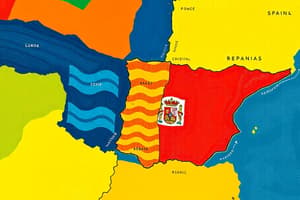Podcast
Questions and Answers
How many provinces are there in Spain?
How many provinces are there in Spain?
- 50 (correct)
- 52
- 54
- 48
There are a total of 20 autonomous communities in Spain.
There are a total of 20 autonomous communities in Spain.
False (B)
What is the role of the National Statistics Institute (INE) in Spain?
What is the role of the National Statistics Institute (INE) in Spain?
To collect and publish official data on the Spanish population.
Spain is the _____ most populous country in the European Union.
Spain is the _____ most populous country in the European Union.
Match the following terms with their definitions:
Match the following terms with their definitions:
Which period saw the highest levels of migration from the interior of Spain to coastal areas?
Which period saw the highest levels of migration from the interior of Spain to coastal areas?
The majority of Spain's population growth has occurred in rural areas.
The majority of Spain's population growth has occurred in rural areas.
Name two autonomous communities in Spain that account for a significant portion of the population.
Name two autonomous communities in Spain that account for a significant portion of the population.
In the 1960s, rural inhabitants migrated to coastal areas seeking _______.
In the 1960s, rural inhabitants migrated to coastal areas seeking _______.
Match the following regions with their characteristics:
Match the following regions with their characteristics:
Flashcards
Spanish Administrative Levels
Spanish Administrative Levels
Spain's government is organized into municipalities, provinces, and autonomous communities.
Autonomous Communities
Autonomous Communities
Groups of provinces in Spain with shared characteristics (geography, culture).
Municipal Register (Padrón)
Municipal Register (Padrón)
Official record of people living in a Spanish municipality.
Spanish Population Size
Spanish Population Size
Signup and view all the flashcards
National Statistics Institute (INE)
National Statistics Institute (INE)
Signup and view all the flashcards
What is the most basic administrative division in Spain?
What is the most basic administrative division in Spain?
Signup and view all the flashcards
How many provinces are there in Spain?
How many provinces are there in Spain?
Signup and view all the flashcards
What are Autonomous Communities?
What are Autonomous Communities?
Signup and view all the flashcards
Where is the data about Spain's population collected?
Where is the data about Spain's population collected?
Signup and view all the flashcards
What is the 'Padrón'?
What is the 'Padrón'?
Signup and view all the flashcards
Spanish Population Distribution
Spanish Population Distribution
Signup and view all the flashcards
Coastal Concentration in the 19th Century
Coastal Concentration in the 19th Century
Signup and view all the flashcards
Tourism's Impact on Population
Tourism's Impact on Population
Signup and view all the flashcards
Spain's Most Populated Regions
Spain's Most Populated Regions
Signup and view all the flashcards
Population Shifts in Spain
Population Shifts in Spain
Signup and view all the flashcards
Study Notes
Spanish Administrative Divisions
- Spain's administrative divisions range from municipalities (most basic) to autonomous communities (highest).
- Municipalities are the most basic administrative divisions of the Spanish territory.
- Provinces are administrative divisions composed of municipalities; they are both a territorial and local authority. There are 50 provinces in Spain.
- Autonomous communities are groups of provinces sharing geographical, historical, and cultural characteristics. Spain has 17 autonomous communities and 2 autonomous cities (Ceuta and Melilla).
Population Information
- Spain's population is approximately 50 million, ranking 5th in the EU after Germany, France, UK, and Italy.
- The INE (National Statistics Institute) collects and publishes official population data.
- Key population data includes the census which records resident populations of municipalities, including their social, economic, and cultural characteristics.
- The municipal register (Padrón) tracks population by municipality.
- Civil registers record births and deaths.
Studying That Suits You
Use AI to generate personalized quizzes and flashcards to suit your learning preferences.
Description
Explore the structure of Spain's administrative divisions, from municipalities to autonomous communities. This quiz covers the key characteristics and population information related to these divisions, including their roles and significance in Spanish governance. Test your knowledge of Spain's unique territorial organization.




